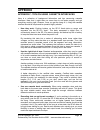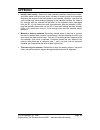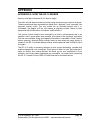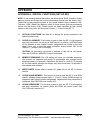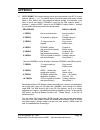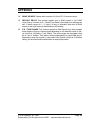- DL manuals
- E-Mu
- Drums
- SP-12
- Owner's Manual
E-Mu SP-12 Owner's Manual
Summary of SP-12
Page 1
Sp-12 sampling percussion system owners manual by craig anderton version 2.3 © 1985 e-mu systems, inc. Scotts valley, ca. All rights reserved.
Page 2: Contents
Contents © e-mu systems, inc. 1985 page 2 enhanced by the emulator archive 2002 www.Emulatorarchive.Com table of contents introduction..............................................................................................6 what is it? .............................................................
Page 3: Contents
Contents © e-mu systems, inc. 1985 page 3 enhanced by the emulator archive 2002 www.Emulatorarchive.Com 1n playing back segments ..................................................................... 21 1o setting tempo.....................................................................................
Page 4: Contents
Contents © e-mu systems, inc. 1985 page 4 enhanced by the emulator archive 2002 www.Emulatorarchive.Com 3g changing the song drum sound mix.............................................. 47 3h setting song tempo ............................................................................ 48 3i progra...
Page 5: Contents
Contents © e-mu systems, inc. 1985 page 5 enhanced by the emulator archive 2002 www.Emulatorarchive.Com 6c internal sync (sync 1) ........................................................................ 73 6d midi sync (sync 2) ...........................................................................
Page 6: Introduction
Introduction © e-mu systems, inc. 1985 page 6 enhanced by the emulator archive 2002 www.Emulatorarchive.Com introduction what is it sp-12 ground rules settings and values the transitory nature of segment mode beep messages.
Page 7: Introduction
Introduction © e-mu systems, inc. 1985 page 7 enhanced by the emulator archive 2002 www.Emulatorarchive.Com what is it? The sp-12 is the latest member of e-mu’s family of high - technology musical instruments. It combines the most popular features of our first drum machine, the drumulator, along wit...
Page 8: Introduction
Introduction © e-mu systems, inc. 1985 page 8 enhanced by the emulator archive 2002 www.Emulatorarchive.Com sp-12 ground rules here are all the background terms you will need to know in order to make sense of the manual. Activating and de-activating modules the sp-12 is organized as seven modules: s...
Page 9: Introduction
Introduction © e-mu systems, inc. 1985 page 9 enhanced by the emulator archive 2002 www.Emulatorarchive.Com settings and values there are two ways of altering the sp-12’s parameters. One is to alter a slider setting this is typically done when changing levels, pitch, and so on. The other is to speci...
Page 10: Introduction
Introduction © e-mu systems, inc. 1985 page 10 enhanced by the emulator archive 2002 www.Emulatorarchive.Com the transitory nature of segment mode segment mode is the sp-12’s “scratchpad” where you work up rhythmic segments prior to combining them in songs. Therefore, tempos, mixes, and most other s...
Page 11: Getting Ready
Getting ready © e-mu systems, inc. 1985 page 11 enhanced by the emulator archive 2002 www.Emulatorarchive.Com part 1: getting ready 1a setup 1b instant gratification! 1c background: the performance module 1d selecting drum sounds 1e adjusting the mix 1f tuning the drums/changing decay 1g background:...
Page 12: Getting Ready
Getting ready © e-mu systems, inc. 1985 page 12 enhanced by the emulator archive 2002 www.Emulatorarchive.Com 1a setup important!! Before you turn on your sp-12: there is a 115/230 volt selector switch on the back of the sp-12, next to the on/off switch. Make sure the ac voltage indicated on the swi...
Page 13: Getting Ready
Getting ready © e-mu systems, inc. 1985 page 13 enhanced by the emulator archive 2002 www.Emulatorarchive.Com 1b instant gratification! Yes, the sp-12 is an extremely versatile device. But that versatility means that in order to learn about all the options, you’ll have to spend a few hours with the ...
Page 14: Getting Ready
Getting ready © e-mu systems, inc. 1985 page 14 enhanced by the emulator archive 2002 www.Emulatorarchive.Com 1c background: the performance module this module is where you select drum sounds, tuning, drum mix, and so on. All of these adjustments reset to their default values when the sp-12 is turne...
Page 15: Getting Ready
Getting ready © e-mu systems, inc. 1985 page 15 enhanced by the emulator archive 2002 www.Emulatorarchive.Com 1e adjusting the mix 1. Press the tune-mix-multi switch (towards the upper left corner of the performance module) until the mix led lights. The display graphically shows the level of each dr...
Page 16: Getting Ready
Getting ready © e-mu systems, inc. 1985 page 16 enhanced by the emulator archive 2002 www.Emulatorarchive.Com 1f tuning the drums/changing decay (set-up 18) 1. You may tune or change the decay time of any of the drum sounds. Cymbals may also be tuned, but due to the nature of the sp-12’s tuning chan...
Page 17: Getting Ready
Getting ready © e-mu systems, inc. 1985 page 17 enhanced by the emulator archive 2002 www.Emulatorarchive.Com 1h accessing/exiting multilevel (set-up 12 & 13) 1. Activate the set-up module by pressing its button. Its led will glow, and the display will ask for a function from the list printed to the...
Page 18: Getting Ready
Getting ready © e-mu systems, inc. 1985 page 18 enhanced by the emulator archive 2002 www.Emulatorarchive.Com 1i accessing/exiting multipitch (set-up 11 & 13) 1. Activate the set-up module by pressing its switch. Its led will glow, and the display will ask for a function from the list printed to the...
Page 19: Getting Ready
Getting ready © e-mu systems, inc. 1985 page 19 enhanced by the emulator archive 2002 www.Emulatorarchive.Com 1j accessing dynamics (set-up 14) yes, the harder you hit the buttons the louder the sound. We did this in such an incredibly ingenious way that engineers across the country will burst out l...
Page 20: Getting Ready
Getting ready © e-mu systems, inc. 1985 page 20 enhanced by the emulator archive 2002 www.Emulatorarchive.Com 1l auditioning (selecting) a mix (set-up 16) you may select an already defined drum mix (see section 1k) which will assign the mix levels to the drum sounds in all four banks. 1. Activate th...
Page 21: Getting Ready
Getting ready © e-mu systems, inc. 1985 page 21 enhanced by the emulator archive 2002 www.Emulatorarchive.Com 1n playing back segments you can record and play back 100 rhythm patterns called segments. These are numbered from 00 through 99. Several segments were loaded into the sp-12 at the factory; ...
Page 22: Getting Ready
Getting ready © e-mu systems, inc. 1985 page 22 enhanced by the emulator archive 2002 www.Emulatorarchive.Com 1o setting tempo the tempo may be varied from 40 to 240 beats per minute. Segment tempo settings are “remembered” by the sp-12 only while you are in segment mode. If you switch over to song ...
Page 23: Getting Ready
Getting ready © e-mu systems, inc. 1985 page 23 enhanced by the emulator archive 2002 www.Emulatorarchive.Com 1p programming the metronome when playing back or recording segments, you can program the metronome for a variety of different beats. The metronome produces an accented click on the first be...
Page 24: Recording Segments
Recording segments © e-mu systems, inc. 1985 page 24 enhanced by the emulator archive 2002 www.Emulatorarchive.Com part 2: recording segments 2a overview 2b erasing a segment 2c “dimensioning” a segment 2d understanding auto correct 2e setting auto correct 2f recording a segment in realtime 2g recod...
Page 25: Recording Segments
Recording segments © e-mu systems, inc. 1985 page 25 enhanced by the emulator archive 2002 www.Emulatorarchive.Com 2a recording a segment - overview there are two ways to record a segment, real time and step time. In both cases, recording initially consists of: 1. Programming the metronome (if neces...
Page 26: Recording Segments
Recording segments © e-mu systems, inc. 1985 page 26 enhanced by the emulator archive 2002 www.Emulatorarchive.Com 2b erasing a segment erasing a segment clears out all existing drum sounds, and automatically re- dimensions the segment to two measures of 4/4. Before erasing a segment, always check w...
Page 27: Recording Segments
Recording segments © e-mu systems, inc. 1985 page 27 enhanced by the emulator archive 2002 www.Emulatorarchive.Com part 1: standard dimensioning 1. Set the time signature by pressing time signature. The display will probably show the 04/4 default time signature and a cursor will be flashing under th...
Page 28: Recording Segments
Recording segments © e-mu systems, inc. 1985 page 28 enhanced by the emulator archive 2002 www.Emulatorarchive.Com part 2: real-time dimensioning real-time dimensioning mode is useful when you want a segment’s length to be other than some number of whole measures and beats (i.E. If you wanted 2 meas...
Page 29: Recording Segments
Recording segments © e-mu systems, inc. 1985 page 29 enhanced by the emulator archive 2002 www.Emulatorarchive.Com 2d understanding auto correct auto correct lets you create patterns with perfect timing by placing whatever drum sound you play on your choice of the nearest eighth note, eighth note tr...
Page 30: Recording Segments
Recording segments © e-mu systems, inc. 1985 page 30 enhanced by the emulator archive 2002 www.Emulatorarchive.Com fig. 2-3 this illustrates an important point: use the least amount of resolution needed. If you are recording a simple snare back beat, there’s no point in using an auto correct setting...
Page 31: Recording Segments
Recording segments © e-mu systems, inc. 1985 page 31 enhanced by the emulator archive 2002 www.Emulatorarchive.Com 2e setting auto correct to set auto correct, the sp-12 must be in segment mode. The sp12 can be stopped or running (recording). 1. Press auto correct. The display shows the current auto...
Page 32: Recording Segments
Recording segments © e-mu systems, inc. 1985 page 32 enhanced by the emulator archive 2002 www.Emulatorarchive.Com b. Change tempo by pressing the tempo button. C. Change auto correct by pressing auto correct and using the left and right arrow buttons. D. Change the mix by selecting mix with the tun...
Page 33: Recording Segments
Recording segments © e-mu systems, inc. 1985 page 33 enhanced by the emulator archive 2002 www.Emulatorarchive.Com 2g recording a segment in step time here is an alternate way to record and edit drum sounds which is particularly helpful with unusual rhythms. 1. If necessary, program the auto correct...
Page 34: Recording Segments
Recording segments © e-mu systems, inc. 1985 page 34 enhanced by the emulator archive 2002 www.Emulatorarchive.Com 2h erasing a specific drum sound when you are in segment mode and editing a segment, you may erase a drum/percussion sound wherever it appears in the segment. 1. Stop the sp-12, confirm...
Page 35: Recording Segments
Recording segments © e-mu systems, inc. 1985 page 35 enhanced by the emulator archive 2002 www.Emulatorarchive.Com 2j copying and appending segments you may copy a segment to one or more other segments. For example, suppose you set up a great hi-hat and bass drum pattern in segment 54. Now suppose y...
Page 36: Recording Segments
Recording segments © e-mu systems, inc. 1985 page 36 enhanced by the emulator archive 2002 www.Emulatorarchive.Com 2k adding swing while in segment mode, you may specify that a segment have a particular rhythmic swing to it. The sp-12 defaults to a “swing factor” of 50%, which means that each quarte...
Page 37: Recording Segments
Recording segments © e-mu systems, inc. 1985 page 37 enhanced by the emulator archive 2002 www.Emulatorarchive.Com 2l swapping drum sounds after recording the segment, you might come to the realization that a part would sound better with, say, the electric snare than the regular snare. No problem! J...
Page 38: Recording Segments
Recording segments © e-mu systems, inc. 1985 page 38 enhanced by the emulator archive 2002 www.Emulatorarchive.Com 2n clearing the memory if you reach a memory full condition (as indicated by the display), save what you have on cassette or disk. After doing this, you will probably want to clear some...
Page 39: Creating A Song
Creating a song © e-mu systems, inc. 1985 page 39 enhanced by the emulator archive 2002 www.Emulatorarchive.Com part 3: creating a song 3a creating a song: overview 3b selecting a song 3c chaining segments together 3d ending a song 3e editing songs (stepping, inserting, deleting) 3f using repeats 3g...
Page 40: Creating A Song
Creating a song © e-mu systems, inc. 1985 page 40 enhanced by the emulator archive 2002 www.Emulatorarchive.Com 3a creating a song: overview there are two ways to create songs using segments. One way is to simply run the sp-12 and key in each segment just before you want it to appear. However, a far...
Page 41: Creating A Song
Creating a song © e-mu systems, inc. 1985 page 41 enhanced by the emulator archive 2002 www.Emulatorarchive.Com note: when going to song mode from segment mode, segment level and tempo settings are not transferred over to the song. Instead, each song has its own programmed tempo (see section 3h) and...
Page 42: Creating A Song
Creating a song © e-mu systems, inc. 1985 page 42 enhanced by the emulator archive 2002 www.Emulatorarchive.Com 3c chaining segments together as mentioned in the overview, it’s best to write out the order of segments you want to program into a song. Let’s try a simple example: segment # section of s...
Page 43: Creating A Song
Creating a song © e-mu systems, inc. 1985 page 43 enhanced by the emulator archive 2002 www.Emulatorarchive.Com 3d ending a song after programming your song, you have several ways to end it. This assumes that you’ve already entered all the segments, and that you are one step past the last step in wh...
Page 44: Creating A Song
Creating a song © e-mu systems, inc. 1985 page 44 enhanced by the emulator archive 2002 www.Emulatorarchive.Com 3e editing songs (stepping, inserting, deleting) 1. Stepping: to change a song step, locate the step with the right arrow and left arrow buttons. Pressing right arrow increases the step nu...
Page 45: Creating A Song
Creating a song © e-mu systems, inc. 1985 page 45 enhanced by the emulator archive 2002 www.Emulatorarchive.Com 3f using repeats you may enclose a segment, or group of segments, inside repeat instructions to repeat the segment(s) a selected number of times. This not only simplifies song programming,...
Page 46: Creating A Song
Creating a song © e-mu systems, inc. 1985 page 46 enhanced by the emulator archive 2002 www.Emulatorarchive.Com we can simplify this by using the repeat function: song step # segment to be played or instruction step 1: begin repeat step 2: 61 step 3: end repeat 4 ( ┼ 4) step 4: 62 step 5: 63 step 6:...
Page 47: Creating A Song
Creating a song © e-mu systems, inc. 1985 page 47 enhanced by the emulator archive 2002 www.Emulatorarchive.Com 8. When you reach step 13, press repeat to end the repeat, and then press 05 to indicate that you want segments 65, 66, 67, and 68 repeated five times. Finally, press enter to enter this s...
Page 48: Creating A Song
Creating a song © e-mu systems, inc. 1985 page 48 enhanced by the emulator archive 2002 www.Emulatorarchive.Com 3h setting song tempo each song can have its own programmed tempo from 40 to 240 beats per minute. 1. To change tempo (the sp-12 may be stopped or running and in or out of’ edit mode), pre...
Page 49: Creating A Song
Creating a song © e-mu systems, inc. 1985 page 49 enhanced by the emulator archive 2002 www.Emulatorarchive.Com 3i programming tempo changes within a song the tempo change feature is very handy if you want to program the tempo to speed up or slow down at specific places in the song. You may introduc...
Page 50: Creating A Song
Creating a song © e-mu systems, inc. 1985 page 50 enhanced by the emulator archive 2002 www.Emulatorarchive.Com 3j jumping to a sub-song at any point in a song, you may jump to another song. This song will play through in its entirety, at which point you will return to the first song at the same poi...
Page 51: Creating A Song
Creating a song © e-mu systems, inc. 1985 page 51 enhanced by the emulator archive 2002 www.Emulatorarchive.Com 3. When the display shows the desired trigger value, press enter. When playing back the song, the trigger pulses will begin (or change, or end, depending on what you programmed) simultaneo...
Page 52: Creating A Song
Creating a song © e-mu systems, inc. 1985 page 52 enhanced by the emulator archive 2002 www.Emulatorarchive.Com 3m efficient use of memory the more efficiently you use memory, the more space you’ll have available for storing all those wonderful drum patterns. Consider a song where you have an 8 meas...
Page 53: Sampling Your Own Sounds
Sampling your own sounds © e-mu systems, inc. 1985 page 53 enhanced by the emulator archive 2002 www.Emulatorarchive.Com part 4: sampling your own sounds 4a sampling: an overview 4b setting levels prior to sampling 4c assigning the sample to a particular user number and output channel 4d setting the...
Page 54: Sampling Your Own Sounds
Sampling your own sounds © e-mu systems, inc. 1985 page 54 enhanced by the emulator archive 2002 www.Emulatorarchive.Com 4a sampling: an overview the sp-12’s sampling capabilities are pretty staggering. Bank 4 has eight sounds (user 1 through user 8) dedicated to sampled sounds. These samples can co...
Page 55: Sampling Your Own Sounds
Sampling your own sounds © e-mu systems, inc. 1985 page 55 enhanced by the emulator archive 2002 www.Emulatorarchive.Com 4b setting levels prior to sampling there are two sample module functions involved in level setting: vu mode (sample 1) and level (sample 3). The module’s gain control trims the r...
Page 56: Sampling Your Own Sounds
Sampling your own sounds © e-mu systems, inc. 1985 page 56 enhanced by the emulator archive 2002 www.Emulatorarchive.Com 4c assigning the sample the sp-12 default assignment places the sampled sound on the lowest available empty user number, with the sound appearing on output channel 7 or 8. Both of...
Page 57: Sampling Your Own Sounds
Sampling your own sounds © e-mu systems, inc. 1985 page 57 enhanced by the emulator archive 2002 www.Emulatorarchive.Com 4e setting the sample length once sampling starts, the sp-12 will normally sample until it runs out of memory or is stopped (section 4f). However, this function let’s you program ...
Page 58: Sampling Your Own Sounds
Sampling your own sounds © e-mu systems, inc. 1985 page 58 enhanced by the emulator archive 2002 www.Emulatorarchive.Com 4. If you are not satisfied with the sample, try again by keying in 6 to re-sample the sound. 4g deleting a user sound recording over a user sound will erase the previous user sou...
Page 59: Sampling Your Own Sounds
Sampling your own sounds © e-mu systems, inc. 1985 page 59 enhanced by the emulator archive 2002 www.Emulatorarchive.Com 4h modifying a sample via truncation and loop truncation shortens a voice’s length by trimming off parts of the beginning and/or end. This allows you to cut off unneeded portions ...
Page 60: Sampling Your Own Sounds
Sampling your own sounds © e-mu systems, inc. 1985 page 60 enhanced by the emulator archive 2002 www.Emulatorarchive.Com 6. Looping can be set at the same time as truncation, or you can loop a previously truncated sample. Looping marks off a section (called a loop) of a user sound. The display indic...
Page 61: Sampling Your Own Sounds
Sampling your own sounds © e-mu systems, inc. 1985 page 61 enhanced by the emulator archive 2002 www.Emulatorarchive.Com fig. 4-1 note: activating set-up and selecting special function 19 sets a default decay for all sounds (as set by slider 1). This is useful if you loop a sound and want it to deca...
Page 62: Saving Your Data
Saving your data © e-mu systems, inc. 1985 page 62 enhanced by the emulator archive 2002 www.Emulatorarchive.Com part 5: saving your data 5a background: saving data 5b general care and handling of disks and cassettes 5c hooking up the 15k1 disk drive or cassette 5d formatting disks 5e disk and casse...
Page 63: Saving Your Data
Saving your data © e-mu systems, inc. 1985 page 63 enhanced by the emulator archive 2002 www.Emulatorarchive.Com 5a background: saving data since you spend a lot of time working on segments, songs, and sampled sounds, you should spend the small amount of time necessary to save them. Don’t just save ...
Page 64: Saving Your Data
Saving your data © e-mu systems, inc. 1985 page 64 enhanced by the emulator archive 2002 www.Emulatorarchive.Com the sp-12 requires double-sided, double-density, 48 tracks per inch (tpi) 5.25” floppy disks. Cassettes should be high-quality data cassettes, not standard audio cassettes. Disk drives ar...
Page 65: Saving Your Data
Saving your data © e-mu systems, inc. 1985 page 65 enhanced by the emulator archive 2002 www.Emulatorarchive.Com to write-protect a cassette, knock out the little tabs on the back of the case as shown in fig. 5-3. These can be covered over with masking tape later if you want to “un- write-protect” t...
Page 66: Saving Your Data
Saving your data © e-mu systems, inc. 1985 page 66 enhanced by the emulator archive 2002 www.Emulatorarchive.Com 5c hooking up the 1541 disk drive or cassette 1. Power off both the sp-12 and the 1541. 2. Patch the disk cable from the plug above the 1541’s fuse post to the sp-12’s rear panel disk jac...
Page 67: Saving Your Data
Saving your data © e-mu systems, inc. 1985 page 67 enhanced by the emulator archive 2002 www.Emulatorarchive.Com gently push the disk all the way in until it can go no further, then push the latch downward until, at the end of its travel, it pops forward somewhat. To hook up the cassette, patch the ...
Page 68: Saving Your Data
Saving your data © e-mu systems, inc. 1985 page 68 enhanced by the emulator archive 2002 www.Emulatorarchive.Com 5e disk and cassette operations cassettes and disks have nine operations in common, as printed in the cassette/disk module. Formatting applies only to disks. Here is a description of each...
Page 69: Saving Your Data
Saving your data © e-mu systems, inc. 1985 page 69 enhanced by the emulator archive 2002 www.Emulatorarchive.Com verify sequences disk: key in 2 then 7 cassette: key 1 then 7 after saving sequences, run this verify function to make sure that the data was saved correctly. The display will let you kno...
Page 70: Midi, Sync & Smpte
Midi, sync & smpte © e-mu systems, inc. 1985 page 70 enhanced by the emulator archive 2002 www.Emulatorarchive.Com part 6: midi, sync, & smpte 6a midi channel and mode select (set-up 22) 6b background: synchronization 6c internal sync (sync 1) 6d midi sync (sync 2) 6e smpte sync (sync 3) 6f click sy...
Page 71: Midi, Sync & Smpte
Midi, sync & smpte © e-mu systems, inc. 1985 page 71 enhanced by the emulator archive 2002 www.Emulatorarchive.Com overview the sp-12 includes several midi functions and synchronization options. We will describe midi options first, then move into synchronization. The non-sync oriented midi functions...
Page 72: Midi, Sync & Smpte
Midi, sync & smpte © e-mu systems, inc. 1985 page 72 enhanced by the emulator archive 2002 www.Emulatorarchive.Com the following table shows which emulator ii keyboard notes trigger which sp- 12 drum sounds (of course, other midi keyboards may also be used). Emulator ii sp-12 c1 bass 1 c#1 cowbell d...
Page 73: Midi, Sync & Smpte
Midi, sync & smpte © e-mu systems, inc. 1985 page 73 enhanced by the emulator archive 2002 www.Emulatorarchive.Com 6b background: synchronization the sp-12 can synchronize to one of several different tempo references: internal clock, external click track, midi timing messages, or smpte time code. It...
Page 74: Midi, Sync & Smpte
Midi, sync & smpte © e-mu systems, inc. 1985 page 74 enhanced by the emulator archive 2002 www.Emulatorarchive.Com note: if for some reason the midi device does not send start/stop commands but does provide timing information, you can set the sp-12 to “ready” mode prior to receiving the mdi signal. ...
Page 75: Midi, Sync & Smpte
Midi, sync & smpte © e-mu systems, inc. 1985 page 75 enhanced by the emulator archive 2002 www.Emulatorarchive.Com note: the midi output “tracks” the smpte output, so if you are driving, say, a midi sequencer from the sp-12 midi out, the sequence will “fast-forward” along with the sp-12. However, yo...
Page 76: Midi, Sync & Smpte
Midi, sync & smpte © e-mu systems, inc. 1985 page 76 enhanced by the emulator archive 2002 www.Emulatorarchive.Com 6g writing smpte time code on tape the sp-12 is a smpte time code generator that can write smpte time code on tape (typically one track of a multitrack recorder), to which the sp-12 can...
Page 77: Midi, Sync & Smpte
Midi, sync & smpte © e-mu systems, inc. 1985 page 77 enhanced by the emulator archive 2002 www.Emulatorarchive.Com 6h writing a 24 ppqn click sync track on tape the sp-12 can write a click track to tape (typically one track of a multitrack recorder), to which the sp-12 can later synchronize. 1. Acti...
Page 78: Mixing and Processing
Mixing and processing © e-mu systems, inc. 1985 page 78 enhanced by the emulator archive 2002 www.Emulatorarchive.Com part 7: mixing and processing 7a mixing and processing: overview 7b pseudo automated mixdown 7c creating ambience 7d using special effects in the studio.
Page 79: Mixing and Processing
Mixing and processing © e-mu systems, inc. 1985 page 79 enhanced by the emulator archive 2002 www.Emulatorarchive.Com 7a mixing and processing: overview sure, the sp-12 sounds astonishingly realistic...But it doesn’t necessarily sound like the drum sounds you hear on records. Why? Because when recor...
Page 80: Mixing and Processing
Mixing and processing © e-mu systems, inc. 1985 page 80 enhanced by the emulator archive 2002 www.Emulatorarchive.Com so far, that’s one channel of ambience. You could add a second channel, but another approach is to split the mono ambient signal into two feeds. One of’ these would be panned left, w...
Page 81: Appendix
Appendix © e-mu systems, inc. 1985 page 81 enhanced by the emulator archive 2002 www.Emulatorarchive.Com appendix appendix a: the art of sampling appendix b: understanding rhythmic notation appendix c: understanding time signatures appendix d: understanding midi/smpte appendix e: tips on creating re...
Page 82: Appendix
Appendix © e-mu systems, inc. 1985 page 82 enhanced by the emulator archive 2002 www.Emulatorarchive.Com appendix a: the art of sampling recording good samples is not always easy; creating a really super set of user sounds requires patience, practice, and skill. Sure, you can get musically useful re...
Page 83: Appendix
Appendix © e-mu systems, inc. 1985 page 83 enhanced by the emulator archive 2002 www.Emulatorarchive.Com removing the ground connection defeats the safety advantage of using a three-wire plug. Make sure the sp-12 chassis - some other path to ground (usually via the audio input and output cables). Ha...
Page 84: Appendix
Appendix © e-mu systems, inc. 1985 page 84 enhanced by the emulator archive 2002 www.Emulatorarchive.Com audio “exciters”: to brighten up a sampled signal, use a device such as an aphex aural exciter or exr projector. Both of these devices add a high-end “sheen” without adding the stridency encounte...
Page 85: Appendix
Appendix © e-mu systems, inc. 1985 page 85 enhanced by the emulator archive 2002 www.Emulatorarchive.Com sampling from tapes maintaining sample quality via vcr recording: one excellent way to sample involves using a vcr and digital audio adapter (sucb as the sony pcm-f1) for recording different soun...
Page 86: Appendix
Appendix © e-mu systems, inc. 1985 page 86 enhanced by the emulator archive 2002 www.Emulatorarchive.Com part 2: manipulating the sample proper use of truncation and looping can conserve memory and create novel effects; let’s show how it’s done with an example. Suppose you want to sample a long, sus...
Page 87: Appendix
Appendix © e-mu systems, inc. 1985 page 87 enhanced by the emulator archive 2002 www.Emulatorarchive.Com.
Page 88: Appendix
Appendix © e-mu systems, inc. 1985 page 88 enhanced by the emulator archive 2002 www.Emulatorarchive.Com appendix b: understanding rhythmic notation this extremely brief overview is intended solely as a refresher and memory jogger; for a detailed description of rhythm notation, see any good book on ...
Page 89: Appendix
Appendix © e-mu systems, inc. 1985 page 89 enhanced by the emulator archive 2002 www.Emulatorarchive.Com appendix c: understanding time signatures a time signature (also called metric signature) describes the meter of a piece of music. It consists of two numbers arranged like a fraction, such as 3/4...
Page 90: Appendix
Appendix © e-mu systems, inc. 1985 page 90 enhanced by the emulator archive 2002 www.Emulatorarchive.Com appendix d: understanding midi/smpte midi is causing a certain amount of confusion among musicians. Fear not -- it’s not all that difficult to understand, and the sp-12 makes it particularly easy...
Page 91: Appendix
Appendix © e-mu systems, inc. 1985 page 91 enhanced by the emulator archive 2002 www.Emulatorarchive.Com particular moment, thus letting you determine the flow of information from one midi device to another. This is why having a specification which manufacturers can follow is so important; it insure...
Page 92: Appendix
Appendix © e-mu systems, inc. 1985 page 92 enhanced by the emulator archive 2002 www.Emulatorarchive.Com the words of greatest interest to the sp-12 relate to pitch and tempo. The sp-12 sounds can respond to different notes being sent over midi (see section 6a); therefore, drum sounds can be played ...
Page 93: Appendix
Appendix © e-mu systems, inc. 1985 page 93 enhanced by the emulator archive 2002 www.Emulatorarchive.Com appendix e: tips on creating realistic drum parts if you’re a drummer, you probably don’t need to read this. But for those of you who are primarily melodic players and are using the sp-12 to augm...
Page 94: Appendix
Appendix © e-mu systems, inc. 1985 page 94 enhanced by the emulator archive 2002 www.Emulatorarchive.Com appendix f: tips on using cassette interfaces here is a collection of background information and tips concerning cassette interfaces. Note that it might take you some time to set levels properly ...
Page 95: Appendix
Appendix © e-mu systems, inc. 1985 page 95 enhanced by the emulator archive 2002 www.Emulatorarchive.Com identify data vocally: since most small cassette machines have built-in mikes, and other decks have mic input jacks, it’s easy to record a brief bit of narration describing the nature of the data...
Page 96: Appendix
Appendix © e-mu systems, inc. 1985 page 96 enhanced by the emulator archive 2002 www.Emulatorarchive.Com appendix g: how the sp-12 works here’s a brief idea of how the sp-12 does its magic. The drum sounds were recorded at a studio using real drums and a human drummer. These sounds were then convert...
Page 97: Appendix
Appendix © e-mu systems, inc. 1985 page 97 enhanced by the emulator archive 2002 www.Emulatorarchive.Com appendix h: special functions (set-up #23) note: in the following feature descriptions the abbreviation “ram” (random access memory) means all sounds that are not permanently burned into the fact...
Page 98: Appendix
Appendix © e-mu systems, inc. 1985 page 98 enhanced by the emulator archive 2002 www.Emulatorarchive.Com 17. Copy sound this function allows you to move any sound in the sp-12 to any location (banks 1 - 4.). You should think of the front panel instrument names (bass 1, rim, user 6, etc.) as location...
Page 99: Appendix
Appendix © e-mu systems, inc. 1985 page 99 enhanced by the emulator archive 2002 www.Emulatorarchive.Com 18. Swap sounds please refer to section 2l of the sp-12 owners manual. 19. Default decay this function applies only to ram sounds in the tune mode (set-up function # 18 – decay/tune select) that ...






























































































